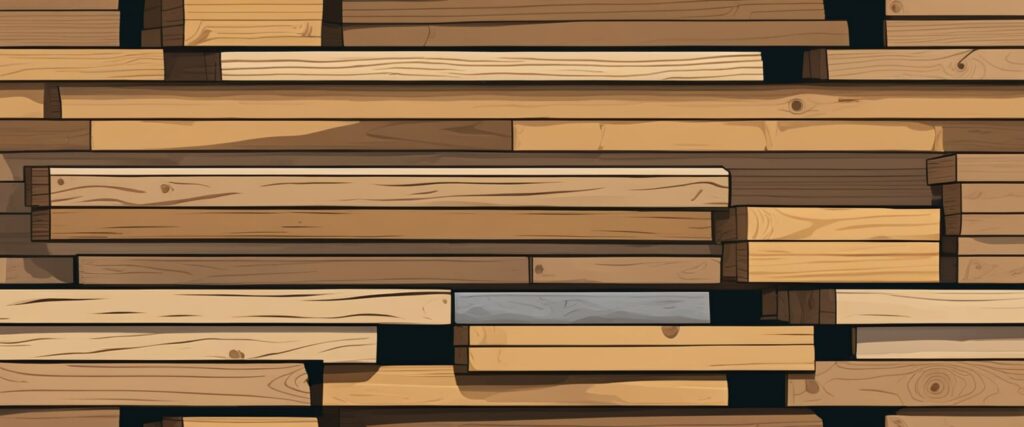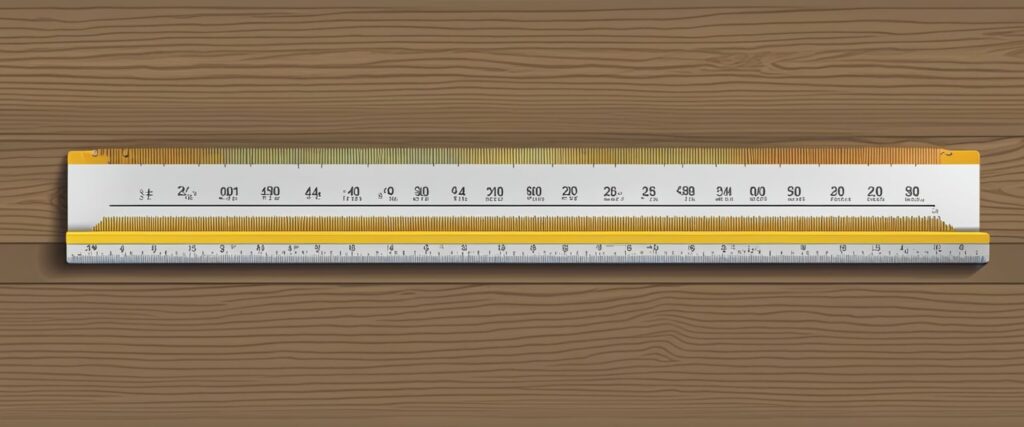A board foot is a unit of measurement used to quantify the volume of lumber. When purchasing wood for various projects, understanding how lumber is measured helps you to estimate costs and ensures you buy an adequate amount. One board foot is defined as a piece of wood that is one foot long, one foot wide, and one inch thick.

This measurement is not simply a surface measure, but a volume calculation. To determine the total board feet in a piece of lumber, the width and length in inches are multiplied together, then divided by 12 to convert to board feet. This formula considers the depth of the wood, which is traditionally one inch for this measure. When dealing with lumber that is thicker or thinner than one inch, the actual thickness is also factored into the calculation.
Key Takeaways
- A board foot measures the volume of lumber, correlating to a piece one foot by one foot by one inch.
- Calculating board feet involves multiplying length by width (in inches) and then dividing by 12.
- Understanding board foot measurement aids in accurately purchasing and utilizing wood for projects.
Understanding the Board Foot
In woodworking and lumber trade, the term ‘board foot’ is crucial for quantifying lumber volume. It fulfills a standardized measurement system, ensuring that the thickness, width, and length of wood are factored into the buying and selling process.
Definition and History
A board foot (bf) represents a unit of measurement for lumber, defined as a piece of wood that is 12 inches long, 12 inches wide, and 1 inch thick, equivalent to 144 cubic inches. Historically, this unit has facilitated the trading of lumber, allowing buyers and sellers to quantify and price different pieces of lumber consistently. One board foot can also be expressed in terms of cubic centimeters (2,360 cm³), which shows its global applicability in both imperial and metric systems.
Board Footage Formula
To calculate the number of board feet (bf) in a piece of lumber, the formula is:
Board Feet (bf) = Thickness (in inches) x Width (in inches) x Length (in feet) / 12
For larger quantities of lumber, measurements might be given in thousand board feet (mbf or mfbm), where 1 mbf equals 1,000 board feet. If you are dealing with a piece of lumber that does not measure exactly in feet or inches, convert all measurements to inches, then apply the formula and divide the final figure by 144 to find the board footage in bf.
Dimensional Comparisons
When comparing dimensions of lumber pieces of different sizes, the board foot as a unit of measurement helps you understand and equate their relative volume. For instance:
- A piece of lumber that is 2 inches thick, 6 inches wide, and 12 feet long is 12 board feet.
- Conversely, a piece of wood 1 inch thick, 3 inches wide, and 24 feet long also sums up to 12 board feet.
Table: Sample Board Foot Calculations for Dimensional Comparisons
| Thickness (inches) | Width (inches) | Length (feet) | Board Feet (bf) |
|---|---|---|---|
| 2 | 6 | 12 | 12 |
| 1 | 3 | 24 | 12 |
These examples demonstrate that different shapes and sizes might hold the same board footage, even though their dimensions vary. Remember, the depth of a piece of lumber does not directly factor into the board foot calculation; it’s about thickness, width, and length.
Application and Calculations
Calculating board feet is essential for cost estimation and material procurement in woodworking and construction projects. It allows you to determine the volume of wood you need and its price.

How to Calculate Board Feet
To calculate board feet (bdft), you use the formula: bdft = width (in) * thickness (in) * length (ft) / 12. That’s because a board foot is defined as a piece of wood that is 12 inches wide, 1 inch thick, and 1 foot long. It’s important to ensure that all measurements are taken in inches and feet for consistency, then convert these dimensions using the formula.
- Example: If you have a piece of wood measuring 6 inches wide, 2 inches thick, and 10 feet long, the calculation would be:
- bdft = (6 * 2 * 10) / 12
- bdft = 120 / 12
- bdft = 10
Tools and Calculators
A variety of tools and calculators are available to help you determine board feet. You can find:
- Simple board foot calculator apps online or as mobile applications.
- Websites offering free calculator tools where you input your dimensions to receive the bdft.
- Physical slide-rule calculators specifically designed for board foot calculations which can be useful if you’re working offline.
When selecting a calculator, choose one that allows for different wood dimensions and automatically converts these into board feet.
Cost Implications
Understanding the calculation of board feet directly affects the cost of your project. Wood is often sold by the board foot, with the price per board foot varying depending on the type of wood. Here’s a breakdown of how costs can be estimated:
Multiply the total board feet by the price per board foot to get your estimated cost:
- Cost = bdft * price per bdft
- Remember to account for extra material for cuts and redesigns, which will alter the total board feet and thus the cost. It’s not unusual to purchase 10-15% more wood than calculated to cover these contingencies.
- Always confirm the price per board foot with your supplier as it may change depending on market conditions and wood grade.
By mastering board feet calculations and their cost implications, you can effectively budget your construction or woodworking projects.
Lumber Varieties and Measurement
In this section, you’ll gain an understanding of the differences between hardwood and softwood, the standard lumber dimensions, and how volume and weight affect your lumber purchases.
Hardwood vs. Softwood
Hardwoods are typically sourced from deciduous trees, known for their broad leaves and seasonal foliage changes. Examples include oak and maple. They’re often used for furniture and floors. Softwoods come from coniferous trees, like pine and fir, and are used in construction and paper production due to their faster growth rates.
- Hardwood Lumber: Denser and often more durable; ideal for fine woodworking.
- Softwood Lumber: Generally lighter and more pliable; predominantly used in construction.
Lumber Dimensions
When you buy lumber, you’ll encounter terms like “nominal” and “actual” dimensions. Nominal dimensions refer to the size of the lumber when it is first cut, while actual dimensions are the final size after the wood has been dried and planed.
- Nominal Width: The width of the lumber in inches as cut at the sawmill.
- Actual Width: The width of the lumber in inches after being dried and planed.
For example, what is sold as a “2×4” is actually closer to 1.5 inches by 3.5 inches in actual width and thickness.
Stock Dimensions: Standard dimensional materials are often sold in predetermined sizes like 1 x 4, 2 x 4, or 4 x 4.
Volume and Weight Comparisons
Board footage is a measurement of volume in the lumber industry. One board foot equals a piece of wood that is 12 inches long, 12 inches wide, and 1 inch thick. This is different from square footage, which is a measure of area.
| Measurement | Description |
|---|---|
| Board Foot | 144 square inches of lumber, usually used for pricing lumber stock. |
| Lineal Foot | A one-dimensional linear measure, often used for trim and molding. |
- Density: This impacts both the weight and strength of the wood. Different species have varying densities.
- Weights: Often expressed in pounds per board foot, this can affect shipping costs and structural decisions.
When you’re planning a project involving hardwood lumber or softwood, keep these measurements in mind to make informed decisions on wood species, dimensions, and volume for your woodworking or construction needs.
Purchasing and Utilization

When buying and utilizing board feet, your ability to assess material quality and calculate needs is fundamental to project success.
Buying Tips
When purchasing wood in board feet from lumberyards or sawmillers, it’s essential to know common sizing terminology. A board foot is a measurement of volume equal to a 1-inch thick, 12-inch wide, and 1-foot long wooden board. For example, a standard 2×4 is actually 1 1/2 inches by 3 1/2 inches and is sold in linear feet, not board feet. On the other hand, thicker planks like a 5/4 stack-like deck plank, which are often used for decking, are sold by the board foot.
- Lumberyard Selection: Choose reputable lumberyards or mills in the United States or Canada that offer quality oak or other wood species.
- Understanding Grades: Wood is graded based on grain, imperfections, and defects. Familiarize yourself with the grades to ensure you get the best material for your project.
- Price Comparison: Prices may vary between sawmillers and lumberyards. Compare costs per board foot to get the best deal.
Here’s a simplified table to assist in visualizing different wood sizes and their corresponding board feet:
| Size (Thickness x Width x Length) | Board Feet |
|---|---|
| 2×4 x 8′ (1.5″ x 3.5″ x 8′) | 5.33 BF |
| 5/4 x 6 x 12′ (1″ x 5.5″ x 12′) | 5.5 BF |
Ensure correct calculations to avoid excess material and costs.
Utilizing Board Feet in Projects
Board feet calculations are integral to project planning. Accurate measurements help in determining the exact amount of material needed, minimizing waste.
- Project Plans: Before a visit to the lumberyard, have detailed project plans to estimate the total board feet required.
- Cut Lists: Prepare a cut list to maximize each board’s use, accounting for the grain direction and potential waste due to defects.
- Conversion Consideration: Remember that the nominal size (e.g., 2×4) differs from actual measurements. Use actual sizes for precise board foot calculations.
Accounting for material imperfections and planning cuts around them ensures better utilization of each board foot purchased.
Frequently Asked Questions

When working with lumber or engaging in a woodworking project, understanding the concept of a board foot is essential for purchasing materials and planning your work.
How is a board foot measurement used in the lumber industry?
In the lumber industry, a board foot is a unit of measure that quantifies the volume of lumber. You use this measurement to buy and sell wood, ensuring that you get a standardized quantity no matter the length, width, or thickness of the boards.
Can you explain how to convert cubic inches to board feet?
To convert cubic inches to board feet, you divide the number of cubic inches by 144. Since one board foot is equal to 144 cubic inches, this conversion helps you understand the volume of wood you are dealing with in board feet.
What are the steps to calculate board feet for a woodworking project?
To calculate board feet for a woodworking project, you multiply the width in inches, the length in feet, and the thickness in inches of the lumber. Then, divide the total by 12. The formula is: (Width x Length x Thickness) / 12.
How does board foot determine the quantity of spray foam insulation?
The term is not typically used in measuring spray foam insulation. Spray foam is often measured in square feet covered at a certain thickness, not in board feet.
What does the term ‘200 board feet of lumber’ represent?
The term ‘200 board feet of lumber’ indicates the volume of wood you have. It’s the equivalent of 200 pieces of wood, each one foot long, one foot wide, and one inch thick.
In what way is board footage applied in the context of construction?
In construction, board footage is employed to determine the quantity of wood needed for a project. You can budget and plan for the amount of material required for framing, creating structures, and other architectural elements.


